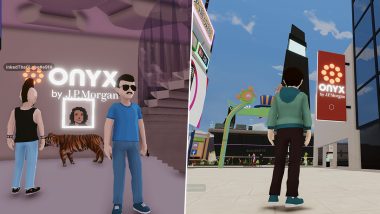Mumbai, June 29: Three dimensional models of our world are being re-created as virtual avatars and are drawing in real money in the hundreds of millions. The biggest draw after cryptocurrency is the Metaverse real estate market which is being touted to become a multi-trillion market by 2030.
Big companies and big names are betting on the virtual world. The argument is that internet users are already spending hours caught up in various apps so they will be interested in exploring a world that can give them something new and entertaining. The gaming community is estimated to be three billion strong however these numbers are not confirmed. Early movers like Adidas, and Meta (erstwhile Facebook) are pioneering the way and betting that technology and infrastructure will allow people/ users to spend more hours and in turn money in this virtual reality.
Adidas launched itself in the Metaverse in December ’21, with its NFT labelled Into the Metaverse available for purchase which would provide users access to Adidas Original products and experiences. Closer home, Union Square House, a real-estate brokerage firm in Dubai has announced the launch of MENA region’s first Metaverse mansions this year. The multi-billion dollar firm will join the dozens of platforms selling real estate in the Metaverse, even as new entrants bring new competition weekly.
With so many sellers entering the market, the question is who is investing in the ever-expanding virtual universe and how does one assess value? Especially, as the crypto-market has been rocked by this year’s crash. How does a user or purchaser assign value to an asset which has no history or understand the risk?
For the uninitiated, the process of investing in the virtual real estate market happens through the purchase and exchange of non-fungible tokens (or NFTs). The NFT should not be confused with crypto-currency as the former is a unique cryptographic token that is not mutually interchangeable. The NFT is also not divisible like real-world currency.
Some real estate firms who have moved to acquire land in the Metaverse are those who already have exposure to other digital assets and clients who understand the risks and benefits of crypto-based virtual worlds. However, one adage that has transferred well from the real to the virtual is ‘location, location, location.’ Real estate in the Metaverse is valued on the prospective location, neighbourhood, neighbours (Snoop Dog, Paris Hilton), and the potential for development.
Does investing in the metaverse entail huge risks?
The Metaverse real estate market can be kindly described as the ‘wild wild west’ of the 1800s or the U.S. West Coast gold rush of the same century. The market is unregulated and ungoverned. If the platform you purchased with, for example The Sandbox, disappears in to the ether of the internet, your virtual property bought with real money, disappears. The same applies to the possibility of a nouveau buyer getting cheated if the seller acts in bad faith.
The other critical question is that of land valuation in the Metaverse platforms. Platforms like Meta have brought in artificial scarcity by releasing a limited number of plots for sale, mimicking the real world where land is a finite resource. But, nothing stops these same platforms from programming more in the virtual world, where land is an infinite resource or rather something controlled by the platforms themselves.
The other significant risk that a buyer should be aware of is the process of virtual real estate transactions itself brings in a double-risk factor. The transaction of purchasing virtual land happens through NFTs, which are linked to cryptocurrency and are extremely volatile themselves. Double Jeopardy!
What are the potential benefits and possible use cases for metaverse real estate?
While many brands and companies chose to stay away from cryptocurrency due to regulatory issues, Metaverse is seeing brands rush in to acquire real estate that is visible and hence marketable. Brands are congregating next to influencers which are bringing in users and this in turn is bringing in more brands to the market square so to speak. Metaverse is becoming the next frontier for advertising. For brands like Adidas, the Metaverse is about purchasing advertising space on the internet today. Global businesses like JP Morgan, HSBC, and Samsung, are some of the other firms who have already bought land in the virtual world.
Apart from using virtual land as a billboard space, Metaverse real estate is the breakthrough star in the digital asset portfolio. Plots of land in the most popular Metaverse platforms such as Sandbox and Decentraland are already selling at 10 to 13 times their original value in a time span of six to ten months.
But, the Facebook lesson teaches us that even with two billion users, platforms can stagnate and hence ensuring engagement and loyalty can promise growth. Metaverse real estate needs to build itself into a community that encourages and rewards engagement through community activity, events, and festivals in order to have a chance to mature.
Definite hype
As of June 2022, Metaverse is pulling in billions of dollars but its virtual nature and the infinite possibilities of the internet ensure there is no guarantee of the permanence of such real estate assets. As of today, there are more questions than answers when it comes to factors such as governance, guarantee, user access, standardization, and the future of the market.
And the big question is unanswered by all tech moguls – how will the virtual world build a unified economy to manage a space that is virtually infinite?
(The above story first appeared on LatestLY on Jun 29, 2022 05:10 PM IST. For more news and updates on politics, world, sports, entertainment and lifestyle, log on to our website latestly.com).













 Quickly
Quickly



